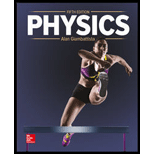
(a)
The value of the current in ammeter
(a)
Answer to Problem 112P
The value of the current in ammeter
Explanation of Solution
Write the expression for the current through the ammeter
Here,
Write the expression for the equivalent resistance.
Here,
Use equation (II) in (I) to solve for
Conclusion:
Substitute
Therefore, the value of the current in ammeter
(b)
The value of the current in ammeter
(b)
Answer to Problem 112P
The value of the current in ammeter
Explanation of Solution
Write the expression for the resistance across the branch through the ammeter
Write the expression for the potential difference right to the ammeter
Write the expression for the current through the ammeter
Use equation (IV) and (V) in (VI) to solve for
Conclusion:
Substitute
Therefore, the value of the current in ammeter
Want to see more full solutions like this?
Chapter 18 Solutions
Physics
- The values of the components in a simple series RC circuit containing a switch (Fig. P21.53) are C = 1.00 F, R = 2.00 106 , and = 10.0 V. At the instant 10.0 s after the switch is closed, calculate (a) the charge on the capacitor, (b) the current in the resistor, (c) the rate at which energy is being stored in the capacitor, and (d) the rate at which energy is being delivered by the battery.arrow_forwardShow that if two resistors R1and R2are combined and one is much greater than the other (R 1 >>R 2 ): (a) Their series resistance is very nearly equal to the greater resistance R 1. (b) Their parallel resistance is very nearly equal to smaller resistance R2.arrow_forwardExplain why R=R0(1 + a?T) for the temperature variation of the resistance R of an object is not as accurate as P=P0(1 + a?T) which gives the temperature variation of resistivity P.arrow_forward
- Consider a series RC circuit as in Figure P18.35 for which R = 1.00 M, C = 5.00 F, and = 30.0 V. Find (a) the time constant of the circuit and (b) the maximum charge on the capacitor after the switch is thrown closed. (c) Find the current in the resistor 10.0 s after the switch is closed. Figure P18.35 Problem 35 and 38.arrow_forwardWith the switch in the circuit of Figure 21.18a open, there is no current in R2. There is current in R1, however, and it is measured with the ammeter at the right side of the circuit. If the switch is closed (Fig. 21.18b), there is current in R2. What happens to the reading on the ammeter when the switch is closed? (a) The reading increases. (b) The reading decreases. (c) The reading does not change.arrow_forwardRegarding the units involved in the relationship t = RC, verify that the units of resistance times capacitance are time, that is, . F = S.arrow_forward
- Power P0 = I0 V0 is delivered to a resistor of resistance R0. If the resistance is doubled (Rnew = 2R0) while the voltage is adjusted such that the current is constant, what are the ratios (a) Pnew/P0 and (b) Vnew/V0? If, instead, the resistance is held constant while Pnew = 2P0, what are the ratios (c) Vnew/V0, and (d) Inew/I0?arrow_forwardFor the circuit shown in Figure P28.55. the ideal voltmeter reads 6.00 V and the ideal ammeter reads 3.00-k. Find (a) the value of K, (b) the emf of the battery, and (c) the voltage across the 3.00-kft resistor.arrow_forwardShow that the power dissipated by the load resistor is maximum when the resistance of the load resistor is equal to the internal resistance of the battery.arrow_forward
- Three identical 60.0-W, 120-V lightbulbs are connected across a 120-V power source as shown in Figure P28.72. Assuming the resistance of each lightbulb is constant (even though in reality the resistance might increase markedly with current), find (a) the total power supplied by the power source and (b) the potential difference across each lightbulb.arrow_forwardConsider the circuit shown in the preceding problem. Write equations for the power supplied by the voltage sources and the power dissipated by the resistors in termsarrow_forwardWhen an unknown resistance Rxis placed in a Wheatstone bridge, it is possible to balance the bridge by adjusting to be 2500 . What is Rxif R2R1 = 0.625?arrow_forward

 Principles of Physics: A Calculus-Based TextPhysicsISBN:9781133104261Author:Raymond A. Serway, John W. JewettPublisher:Cengage Learning
Principles of Physics: A Calculus-Based TextPhysicsISBN:9781133104261Author:Raymond A. Serway, John W. JewettPublisher:Cengage Learning College PhysicsPhysicsISBN:9781938168000Author:Paul Peter Urone, Roger HinrichsPublisher:OpenStax College
College PhysicsPhysicsISBN:9781938168000Author:Paul Peter Urone, Roger HinrichsPublisher:OpenStax College Glencoe Physics: Principles and Problems, Student...PhysicsISBN:9780078807213Author:Paul W. ZitzewitzPublisher:Glencoe/McGraw-Hill
Glencoe Physics: Principles and Problems, Student...PhysicsISBN:9780078807213Author:Paul W. ZitzewitzPublisher:Glencoe/McGraw-Hill Physics for Scientists and EngineersPhysicsISBN:9781337553278Author:Raymond A. Serway, John W. JewettPublisher:Cengage Learning
Physics for Scientists and EngineersPhysicsISBN:9781337553278Author:Raymond A. Serway, John W. JewettPublisher:Cengage Learning Physics for Scientists and Engineers with Modern ...PhysicsISBN:9781337553292Author:Raymond A. Serway, John W. JewettPublisher:Cengage Learning
Physics for Scientists and Engineers with Modern ...PhysicsISBN:9781337553292Author:Raymond A. Serway, John W. JewettPublisher:Cengage Learning





